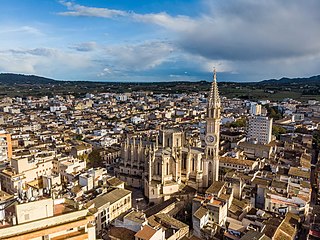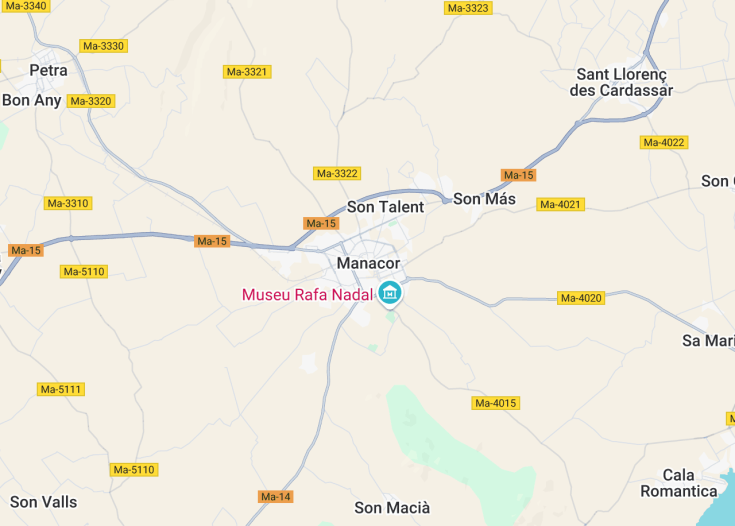Manacor, the second-largest town in Mallorca, is renowned for its historical charm and vibrant culture. Nestled in the eastern part of the island, this town offers visitors a unique blend of traditional Mallorcan architecture and modern amenities. Manacor is famous for its pearl factories and stunning furniture craftsmanship. The town is also a gateway to beautiful coves and beaches, providing a perfect mix of cultural exploration and relaxation opportunities. Its close proximity to various tourist attractions makes Manacor a strategic base for exploring the wider region of Mallorca.
Explore the weekly Monday market in Manacor to find local crafts, fresh produce, and unique souvenirs, capturing the essence of Mallorcan culture.
Visit the Caves of Drach, located nearby, to experience one of the most captivating natural wonders in Mallorca.
Top things to do & see in Manacor
Select the following sights and activities to discover best tickets and tours available in Manacor.
Manacor: The Artisan Heart of Mallorca
| Country | Mallorca (Balearic Islands, Spain) |
| Time in Manacor | GMT+1 |
| Language spoken | Catalan, Spanish |
| Population | 41,801 (source: latest municipal register) |
| Currency | Euro (€, EUR) |
| Airports |
|
Manacor, a significant urban center in the east of Mallorca, is the second-largest town on this sun-drenched island, known for its furniture manufacturing and artificial pearl production. This traditional town features a rich history, with evidence of settlement dating back to around 2000-1200 BC. Over the centuries, it has been under Roman, Byzantine, and Islamic rule, which has influenced its unique cultural and architectural heritage.
Manacor’s charm lies in its vibrant local life, historical buildings, and artisan crafts. The town is also known for its agricultural produce, particularly almonds, figs, and apricots. The weekly Monday market is a colorful spectacle of local fruits, vegetables, crafts, and other products, drawing both tourists and residents. Notably, Manacor is home to tennis superstar Rafael Nadal, and his academy attracts many young talents.
The town provides a more authentic experience compared to the typical tourist spots in Mallorca. Visitors can explore attractions like Torre del Palau, a 14th-century watchtower, and the neo-Gothic style church of Nostra Senyora dels Dolors. The nearby Caves of Drach and Hams are popular attractions, offering stunning stalactites, stalagmites, and one of the largest underground lakes in the world.
Manacor’s rich history and thriving modern community make it an intriguing place for anyone looking to explore the depths of Mallorca’s culture beyond its beaches.
Where is Manacor?
Located in eastern Mallorca, Manacor is a key agricultural and commercial center.
Distances:
| Route | Distance by car | Time by car |
|---|---|---|
| Palma to Manacor | 32 miles | 40 minutes |
| Inca to Manacor | 27 miles | 35 minutes |
| Alcúdia to Manacor | 29 miles | 35 minutes |
What is Manacor famous for?
Manacor is famous for its furniture manufacturing, artificial pearls, and as the birthplace of tennis star Rafael Nadal. It is also renowned for its rich historical heritage and vibrant market culture.
History
Prehistoric to Roman Era (up to 5th century AD)
Manacor, situated on the eastern part of Mallorca in the Balearic Islands, boasts an ancient history dating to prehistoric times. Archaeologists have discovered remnants of talayotic settlements in the area, indicating a vibrant community that thrived long before Roman influence. During the Roman domination of the Balearic Islands, Manacor was known as Manaquaria, serving as a strategic location due to its proximity to the coast.
Islamic and Medieval Period (10th century to 1229 AD)
The region underwent significant changes during the Islamic rule over Mallorca. Agricultural techniques improved, including the introduction of irrigation systems which allowed for the expansion of almond, olive, and fig cultivation. The landscape of Manacor was characterized by its rural villages and farming estates known as ‘alquerias’. However, this era came to an end with the arrival of the Christian conquerors led by King James I of Aragon in the early 13th century.
Late Medieval to Early Modern Era (13th century to 17th century)
Following the Reconquista, Manacor became part of the Kingdom of Mallorca. The town saw the construction of many churches and was gradually fortified. In 1300, King James II officially established Manacor as a town. Its economy during this period was primarily based on agriculture, along with artisanal crafts such as pottery and textile weaving.
19th Century to Present
In the 19th century, Manacor witnessed the growth of the local furniture industry, which became a significant aspect of its economy. The town also saw improvements in infrastructure and education. In modern times, Manacor is renowned for its pearl manufacturing and as the hometown of tennis star Rafael Nadal. The town continues to honor its rich heritage while evolving into a vibrant urban center with a strong sense of local culture.
Visit Manacor
What to see and do in Manacor, Mallorca (Balearic Islands, Spain)
Manacor offers a variety of attractions for visitors, rooted in its rich historical tapestry and vibrant cultural scene. Explore the iconic Coves del Drach, famous for their stunning underground lakes and live classical music performances. Don’t miss the Torre del Palau, a robust defense tower dating back to the 14th century. For a touch of local industry, the Majorica Pearl Factory offers insightful tours on pearl manufacturing.
- Explore the Coves del Drach
- Visit Torre del Palau
- Tour the Majorica Pearl Factory
- Stroll around historic downtown Manacor
- Enjoy local cuisine in traditional restaurants
Festivals and Celebrations in Manacor
Manacor is lively with events throughout the year. The summer months are particularly festive with the Sant Antoni festival in January, featuring bonfires and traditional dances. In June, the town celebrates Corpus Christi with elaborate flower decorations and processions. Autumn brings the vibrant Fires de Manacor, a series of fairs that highlight local crafts, gastronomy, and culture, drawing visitors from across the island.
Best time to visit Manacor
The best time to visit Manacor is during the spring (April to June) or early autumn (September to October). These months offer pleasant weather, ideal for exploring outdoor attractions and participating in local festivals, with fewer crowds compared to the busier summer months.
Is Manacor worth visiting?
Manacor is undoubtedly worth visiting for those who appreciate a blend of historical depth, cultural richness, and natural beauty. The town offers a unique glimpse into the Balearic Islands’ past and present, featuring stunning caves, historical architecture, and vibrant local traditions. Its connection to modern figures like Rafael Nadal adds a contemporary touch to its traditional charm, making it a comprehensive and intriguing destination.










